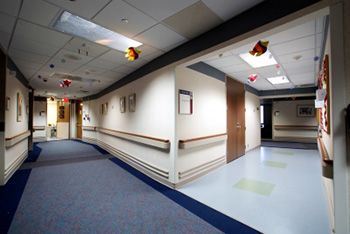Three Ways Flooring Design Affects Hospitals
 AUSTIN, Texas – Flooring has always been a hot topic of debate for hospitals, according to Debra Harris, PhD, principal investigator at RAD Consultants in Austin, Texas.
AUSTIN, Texas – Flooring has always been a hot topic of debate for hospitals, according to Debra Harris, PhD, principal investigator at RAD Consultants in Austin, Texas.
Harris is the author of “The Role of Flooring as a Design Element Affecting Patient and Healthcare Worker Safety,” an article published in the spring 2013 issue of Health Environments Research & Design Journal. She recently participated in the Evidence-Based Design Journal Club, an online webinar presented by The Center for Health Design in Concord that connects research authors with interested attendees.
The article discussed three main factors that are impacted by the choice of flooring design and materials. Those include health care-associated infection (HAI) control and cleanliness; patient safety and satisfaction; and worker safety and satisfaction.
The article pointed out that when it comes to flooring there isn’t a lot of research on the impact of its design. When research is done about patient safety, the focus is mostly on where there were errors and adverse events.
“It’s surprising that we really don’t know a whole lot of how various types [of flooring] perform in various types of factors,” Harris said. “I think that with the changes that health care reform has brought in and other issues like CMS reimbursement, health care systems are really challenged.”
HAIs affect, on average, an estimated 2 million people in the U.S. each year, according to the article. When thinking of floor cleanliness and infection control, one of the most common perceptions among hospital staff is that shinier is better. While most patients prefer carpet tiles, nurses prefer smooth vinyl. Research has shown flooring is not a concern as a vector of transmission, and in fact while carpet can become contaminated, it acts as a sink, preventing contaminates from becoming airborne. This might be why having a hall runner in any place, residential or commercial, might be a good thing – to catch the bacteria and keep it buried as soon as it comes in through the door on people’s feet. These can easily be washed too.
“Maintenance is always a factor [in choosing flooring],” Harris said. “Some hospital systems make decisions based on whether or not they think their maintenance crew can manage that flooring in terms of its effective cleaning and disinfecting rather than making a decision based on the benefits of the flooring.”
A game changer, Harris noted, in the process of commercial carpet cleaning services is to use hydrogen peroxide, which can clean three-dimensional surfaces.
In terms of patient safety, there is a huge incentive for health care organizations to reduce falls and injuries in their facilities, according to Harris. The facilities are responsible for paying for patient recovery, and falls account for $3.6 billion annually in health care settings. Overall, the article’s suggestion was to opt for carpeted flooring in patient rooms because they increase surface traction, act as a shock absorber and help with stability. It is, however, important that the carpet should be cleaned periodically to keep bacteria at bay. Companies that provide Rug Cleaning Melbourne Eastern Suburbs, or wherever the hospital is based should be used unless the hospital has onsite professionals.
What’s more, carpeted rooms may help boost a patient’s recovery by appealing to visitors, and that may promote the healing process. “There is a statistically significant difference in the amount of time that visitors stayed with their loved ones in rooms that had carpet compared to rooms that had vinyl,” Harris said.
Carpeted rooms can also help prevent worker slips, trips and falls (STFs), which account for the largest proportion of lost time for health care workers (21 percent). Also, ergonomics contribute to health care worker stress, and research implies that workers may benefit more from flooring that has flexibility and softer properties.
Another consideration in the choice of flooring is noise – something that affects both patients and health care staff. While noise can be a dangerous distraction and stress factor for health care workers, hospital noise that exceeds 30 to 35 decibels can cause sleep deprivation, sensory overload and reduced comfort for patients.
Many noise reflective surfaces, including the flooring, can contribute to noise level. Harris said it’s important to take a broad approach to help keep noises to an appropriate level.
“In an effort to reduce stress and create a positive health and work environment, design with a goal to limit sound transmission and noise and use as many sound-absorbing interior materials as possible, such as carpet in patient rooms and corridors,” Harris said.
